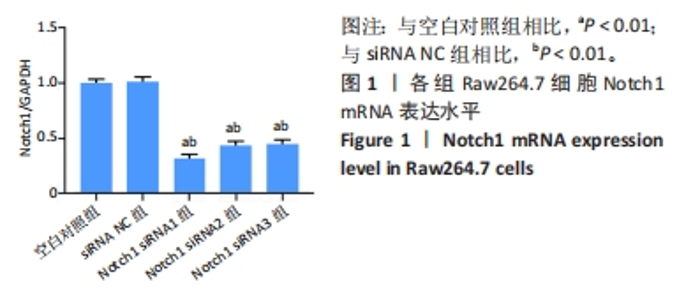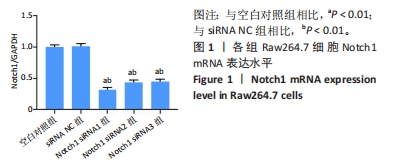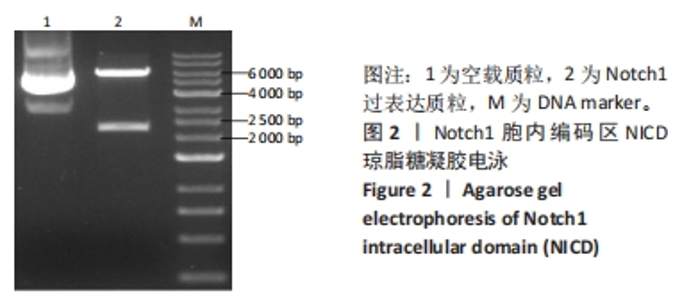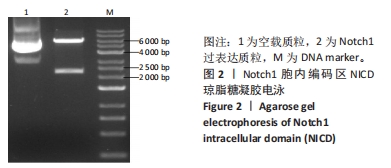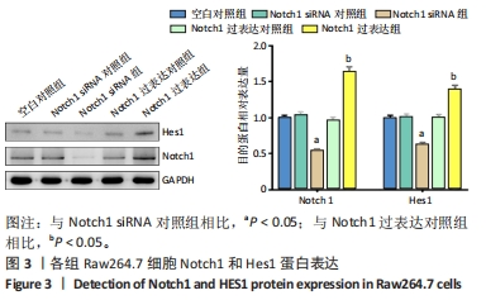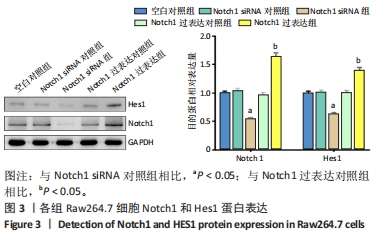Chinese Journal of Tissue Engineering Research ›› 2024, Vol. 28 ›› Issue (35): 5636-5641.doi: 10.12307/2024.595
Previous Articles Next Articles
Puerarin inhibits the differentiation of Raw264.7 cells into osteoclasts through the Notch signaling pathway
Liu Chunli, Yan Yujuan, Mo Liwen, Wu Zhijie, Zhang Li
- School of Stomatology, Hainan Medical University, Haikou 571101, Hainan Province, China
-
Received:2023-11-11Accepted:2023-12-21Online:2024-12-18Published:2024-03-15 -
Contact:Zhang Li, Associate chief physician, School of Stomatology, Hainan Medical University, Haikou 571101, Hainan Province, China -
About author:Liu Chunli, Attending physician, School of Stomatology, Hainan Medical University, Haikou 571101, Hainan Province, China -
Supported by:Hainan Provincial Finance Science and Technology Program Funding Project - Hainan Provincial Key R&D Program for Social Development in 2020, No. ZDYF2020166 (to ZL); Hainan Provincial Finance Science and Technology Program Funding Project - Hainan Provincial Key R&D Program for Social Development in 2023, No. ZDYF2023SHFZ095 (to ZL)
CLC Number:
Cite this article
Liu Chunli, Yan Yujuan, Mo Liwen, Wu Zhijie, Zhang Li. Puerarin inhibits the differentiation of Raw264.7 cells into osteoclasts through the Notch signaling pathway[J]. Chinese Journal of Tissue Engineering Research, 2024, 28(35): 5636-5641.
share this article
Add to citation manager EndNote|Reference Manager|ProCite|BibTeX|RefWorks
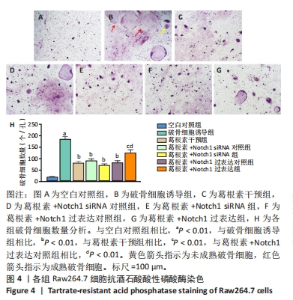
2.3 破骨细胞形成情况 抗酒石酸酸性磷酸酶特异性表达于破骨细胞膜表面,抗酒石酸酸性磷酸酶染色结果显示:与空白对照组相比,Raw264.7细胞经破骨诱导后破骨细胞生成数显著增加;与破骨细胞诱导组相比,葛根素干预组、葛根素+Notch1 siRNA对照组、葛根素+Notch1 siRNA组、葛根素+Notch1过表达对照组破骨细胞生成数明显下降。与葛根素干预组相比,葛根素+Notch1 siRNA对照组、葛根素+Notch1 siRNA组、葛根素+Notch1过表达对照组破骨细胞生成数无明显差异。与葛根素+Notch1 siRNA对照组相比,葛根素+Notch1 siRNA组破骨细胞生成数无明显差异。与葛根素干预组及葛根素+Notch1过表达对照组相比,葛根素+Notch1过表达组破骨细胞生成数明显增加,见图4。"
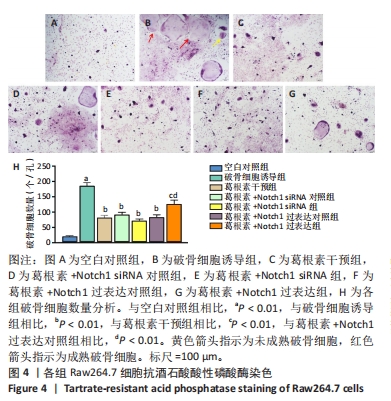
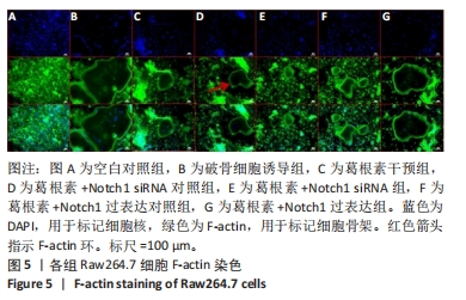
2.4 破骨细胞骨架形成情况 肌动蛋白F-actin染色可以反映细胞骨架的形成情况。与空白对照组相比,Raw264.7细胞经破骨诱导后可见边界明显的F-actin环。与破骨细胞诱导组相比,葛根素干预组、葛根素+Notch1 siRNA对照组、葛根素+Notch1 siRNA组、葛根素+Notch1过表达对照组F-actin环数量及大小均有所下降。与葛根素干预组相比,葛根素+Notch1 siRNA对照组、葛根素+Notch1过表达对照组F-actin环数量及大小无明显差异。与葛根素干预组及葛根素+Notch1 siRNA对照组相比,葛根素+Notch1 siRNA组F-actin环数量及大小均有所下降。与葛根素干预组及葛根素+ Notch1过表达对照组相比,葛根素+Notch1过表达组F-actin环数量及大小有所增加,见图5。"
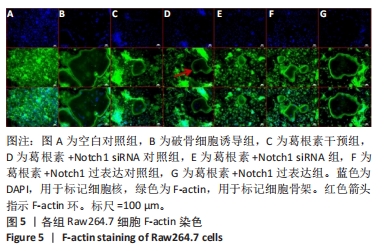
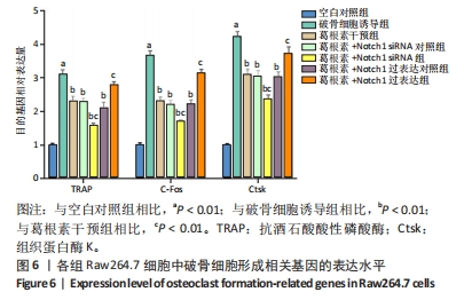
2.5 破骨形成相关基因表达 RT-PCR检测结果显示:与空白对照组相比,Raw264.7细胞经破骨诱导后破骨相关基因抗酒石酸酸性磷酸酶、组织蛋白酶K和c-Fos mRNA表达水平显著上升。与破骨细胞诱导组相比,葛根素干预组、葛根素+Notch1 siRNA对照组、葛根素+Notch1 siRNA组、葛根素+Notch1过表达对照组抗酒石酸酸性磷酸酶、组织蛋白酶K和c-Fos mRNA表达水平明显下降。与葛根素干预组相比,葛根素+ Notch1 siRNA对照组、葛根素+Notch1过表达对照组抗酒石酸酸性磷酸酶、组织蛋白酶K和c-Fos mRNA表达水平无明显差异。与葛根素干预组及葛根素+Notch1 siRNA对照组相比,葛根素+Notch1 siRNA组抗酒石酸酸性磷酸酶、组织蛋白酶K和c-Fos mRNA表达水平明显下降。与葛根素干预组及葛根素+Notch1过表达对照组相比,葛根素+Notch1过表达组抗酒石酸酸性磷酸酶、组织蛋白酶K和c-Fos mRNA表达水平明显上升,见图6。"

| [1] JEONG J, KIM HS, LEE D, et al. Association between Four Dietary Patterns and the Risk of Periodontal Diseases: A Systematic Review and Meta-Analysis. Nutrients. 2022;14(20):4362. [2] MA Q, LIANG M, WU Y, et al. Osteoclast-derived apoptotic bodies couple bone resorption and formation in bone remodeling. Bone Res. 2021;9(1):5. [3] 刘艳,格根塔娜.细胞因子在慢性牙周炎骨吸收中的作用[J].医学信息,2021,34(21):36-38. [4] 王东红,王春爱,薛建军.葛根素的研究进展[J].西部中医药,2017, 30(1):139-142. [5] 闫波.葛根素抑制PMMA颗粒诱导破骨细胞形成及骨溶解的机制研究[D].郑州:郑州大学,2020. [6] 杨一秋,李兰,解继胜,等.葛根素介导PTEN-PI3K-AKT信号通路抑制绝经后骨质疏松症的机制研究[J].中国骨质疏松杂志,2022, 28(3):347-351. [7] 詹乐,马瑞堉,万妮,等.葛根素对牙周炎大鼠Th17/Treg细胞免疫平衡及相关转录因子表达的影响[J].昆明医科大学学报,2022, 43(11):36-43. [8] ZHAO B, GRIMES SN, LI S, et al. TNF-induced osteoclastogenesis and inflammatory bone resorption are inhibited by transcription factor RBP-J. J Exp Med. 2012;209(2):319-334. [9] FUJIWARA T, ZHOU J, YE S, et al. RNA-binding protein Musashi2 induced by RANKL is critical for osteoclast survival. Cell Death Dis. 2016;7(7): e2300. [10] CANALIS E, PARKER K, FENG JQ, et al. Osteoblast lineage-specific effects of notch activation in the skeleton. Endocrinology. 2013;154(2):623-634. [11] 乔松,许琦,叶子青,等.骨保护素对高龄骨质疏松症患者骨代谢的影响[J].解放军医学杂志,2015,40(6):472-474. [12] 刘春丽,闫雨娟,莫礼文,等.葛根素对Raw264.7细胞破骨分化的影响[J].中国组织工程研究,2023,27(32):5114-5119. [13] LI X, LI B, SHI Y, et al. Targeing reactive oxygen species in stem cells for bone therapy. Drug Discov Today. 2021;26(5):1226-1244. [14] LUNDBERG M, SUN S, EBETINO FH, et al. Osteoclasts recycle via osteomorphs during RANKL-stimulated bone resorption. Cell. 2021; 184(5):1330-1347. [15] ABDELMAGID SM, SONDAG GR, MOUSSA FM, et al. Mutation in Osteoactivin Promotes Receptor Activator of NFκB Ligand (RANKL)-mediated Osteoclast Differentiation and Survival but Inhibits Osteoclast Function. J Biol Chem. 2015;290(33):20128-20146. [16] KIM H, LEE K, KIM JM, et al. Selenoprotein W ensures physiological bone remodeling by preventing hyperactivity of osteoclasts. Nat Commun. 2021;12(1):2258. [17] VAN DEN MOLEN E. Penicilline en streptomycine bij periodontitis en paradentitis [Penicillin and streptomycin in the treatment of periodontitis and paradentitis]. Tijdschr Tandheelkd. 1950;57(5):376-379. [18] 路瑞芳,徐莉,冯向辉,等.侵袭性牙周炎基础治疗中不同时机口服抗生素的短期疗效观察[J].中华口腔医学杂志,2012,47(11): 666-670. [19] 梁向阳,李春年.雷尼酸锶对实验性牙周炎大鼠牙槽骨改建的影响[J].口腔医学研究,2021,37(4):310-313. [20] KULCZYŃSKI B, GRAMZA-MICHAŁOWSKA A, SULIBURSKA J, et al. Puerarin-an isoflavone with beneficial effects on bone health. Front Biosci (Landmark Ed). 2021;26(12):1653-1667. [21] ZHOU YX, ZHANG H, PENG C. Puerarin: a review of pharmacological effects. Phytother Res. 2014;28(7):961-975. [22] 朱庆磊,吕欣然,何爱霞.葛根素对氧自由基的清除和抗氧化性损伤作用[J].解放军药学学报,2001,17(1):1-3,13. [23] MIZUKAMI J, TAKAESU G, AKATSUKA H, et al. Receptor activator of NF-kappaB ligand (RANKL) activates TAK1 mitogen-activated protein kinase kinase kinase through a signaling complex containing RANK, TAB2, and TRAF6. Mol Cell Biol. 2002;22(4):992-1000. [24] XIE BP, SHI LY, LI JP, et al. Oleanolic acid inhibits RANKL-induced osteoclastogenesis via ER alpha/miR-503/RANK signaling pathway in RAW264.7 cells. Biomed Pharmacother. 2019;117:109045. [25] SANO T, AKEDA K, YAMADA J, et al. Expression of the RANK/RANKL/OPG system in the human intervertebral disc: implication for the pathogenesis of intervertebral disc degeneration. BMC Musculoskelet Disord. 2019;20(1):225. [26] ARTAVANIS-TSAKONAS S, RAND MD, LAKE RJ. Notch signaling: cell fate control and signal integration in development. Science. 1999; 284(5415):770-776. [27] HAYMAN AR. Tartrate-resistant acid phosphatase (TRAP) and the osteoclast/immune cell dichotomy. Autoimmunity. 2008;41(3): 218-223. [28] 刘官娟,宋娜,霍花,等.唑来膦酸调控NLRP3信号通路抑制脂多糖诱导的破骨细胞分化[J].中国组织工程研究,2023,27(29): 4677-4683. [29] MATSUNO K. Notch signaling. Dev Growth Differ. 2020;62(1):3. [30] PENTON AL, LEONARD LD, SPINNER NB. Notch signaling in human development and disease. Semin Cell Dev Biol. 2012;23(4):450-457. [31] EHEBAUER M, HAYWARD P, MARTINEZ-ARIAS A. Notch signaling pathway. Sci STKE. 2006;2006(364):cm7. [32] FANG ZQ, RUAN B, LIU JJ, et al. Notch-triggered maladaptation of liver sinusoidal endothelium aggravates nonalcoholic steatohepatitis through endothelial nitric oxide synthase. Hepatology. 2022;76(3): 742-758. [33] YOSHIDA G, KAWABATA T, TAKAMATSU H, et al. Degradation of the NOTCH intracellular domain by elevated autophagy in osteoblasts promotes osteoblast differentiation and alleviates osteoporosis. Autophagy. 2022;18(10):2323-2332. [34] 胡超,李适廷,张纲,等.NICD过表达对人牙髓干细胞细胞增殖及细胞迁移的影响[J].牙体牙髓牙周病学杂志,2014,24(4):196-201. [35] 龙晏,邱申彩,李淑慧,等.转化生长因子-β1对人牙周膜干细胞生物学行为的影响[J].中华实用诊断与治疗杂志,2018,32(11): 1044-1046. [36] FILIPOVIĆ M, FLEGAR D, ŠUĆUR A, et al. Inhibition of Notch Signaling Stimulates Osteoclastogenesis From the Common Trilineage Progenitor Under Inflammatory Conditions. Front Immunol. 2022;13:902947. [37] BALLHAUSE TM, JIANG S, BARANOWSKY A, et al. Relevance of Notch Signaling for Bone Metabolism and Regeneration. Int J Mol Sci. 2021; 22(3):1325. [38] 康鑫.葛根素促进成骨细胞增殖及信号调控机制的实验研究[D].兰州:兰州大学,2015. [39] 冯燕陵. FoxO1介导白藜芦醇、葛根素抑制破骨细胞生成和活性的机制研究[D].兰州:兰州大学,2018. [40] 曾芳馨,熊中云.抗酒石酸酸性磷酸酶与骨代谢[J].华西医学,2005, 20(3):545. [41] JULES J, CHEN W, FENG X, et al. C/EBPα transcription factor is regulated by the RANK cytoplasmic 535IVVY538 motif and stimulates osteoclastogenesis more strongly than c-Fos. J Biol Chem. 2018;293(4): 1480-1492. [42] ARMSTRONG AP, TOMETSKO ME, GLACCUM M, et al. A RANK/TRAF6-dependent signal transduction pathway is essential for osteoclast cytoskeletal organization and resorptive function. J Biol Chem. 2002; 277(46):44347-44356. |
| [1] | Yang Yufang, Yang Zhishan, Duan Mianmian, Liu Yiheng, Tang Zhenglong, Wang Yu. Application and prospects of erythropoietin in bone tissue engineering [J]. Chinese Journal of Tissue Engineering Research, 2024, 28(9): 1443-1449. |
| [2] | Huang Haoran, Fan Yinuo, Wei-Yang Wenxiang, Jiang Mengyu, Fang Hanjun, Wang Haibin, Chen Zhenqiu, Liu Yuhao, Zhou Chi. Urolithin A mediates p38/MAPK pathway to inhibit osteoclast activity [J]. Chinese Journal of Tissue Engineering Research, 2024, 28(8): 1149-1154. |
| [3] | Liu Jianhong, Liao Shijie, Li Boxiang, Tang Shengping, Wei Zhendi, Ding Xiaofei. Extracellular vesicles carrying non-coding RNA regulate the activation of osteoclasts [J]. Chinese Journal of Tissue Engineering Research, 2024, 28(7): 1076-1082. |
| [4] | Qiu Xiaoyan, Li Bixin, Li Jingdi, Fan Chuiqin, Ma Lian, Wang Hongwu. Differentiation of insulin-producing cells from human umbilical cord mesenchymal stem cells infected by MAFA-PDX1 overexpressed lentivirus [J]. Chinese Journal of Tissue Engineering Research, 2024, 28(7): 1000-1006. |
| [5] | Wei Yuanxun, Chen Feng, Lin Zonghan, Zhang Chi, Pan Chengzhen, Wei Zongbo. The mechanism of Notch signaling pathway in osteoporosis and its prevention and treatment with traditional Chinese medicine [J]. Chinese Journal of Tissue Engineering Research, 2024, 28(4): 587-593. |
| [6] | Yang Peng, Tang Yubin, Yang Jing, Liu Jian, Yao Runjie, Chen Lin, Su Nan. Protective effect of ulinastatin on acute bone loss in sepsis [J]. Chinese Journal of Tissue Engineering Research, 2024, 28(35): 5649-5655. |
| [7] | Wang Wenchi, Wu Ruiqi, Huang Jierong, Zhu Lifeng, Cui Xianqin, Li Dongzong, Chen Wenhui, Lin Chunting, Cui wei. Molecular mechanism of naringin in prevention and treatment of osteoporosis [J]. Chinese Journal of Tissue Engineering Research, 2024, 28(34): 5528-5535. |
| [8] | Lu Mengya, Wu Xian, She Zeyu, Xia Shuai, Lu Man, Yang Yonghui. Acupotomy prevents knee osteoarthritis in rats by modulating chondrocyte apoptosis in the mitochondrial pathway [J]. Chinese Journal of Tissue Engineering Research, 2024, 28(32): 5190-5195. |
| [9] | Li Ruibo, Kong Ning, Sun Lei, Ma Baodong, Jin Ranran, Zhang Wenjin, Yue Han, Zhang Hui. Erythropoietin-overexpressed umbilical cord mesenchymal stem cells inhibit neuroapoptosis in ischemic-hypoxic SH-SY5Y and its mechanism [J]. Chinese Journal of Tissue Engineering Research, 2024, 28(31): 4937-4944. |
| [10] | Li Huijun, Li Chuikun, Wei Cuilan, Zhang Yeting. Notch1-mediated aerobic exercise promotes hippocampal nerve cell proliferation in Alzheimer’s disease mice [J]. Chinese Journal of Tissue Engineering Research, 2024, 28(31): 4951-4957. |
| [11] | Xue Chunyang, Wang Xiuhui. Icariin regulates acidic microenvironment to alleviate pain caused by postmenopausal osteoporosis in the elderly [J]. Chinese Journal of Tissue Engineering Research, 2024, 28(28): 4461-4468. |
| [12] | Chen Xiangshan, Liu Hua, Sun Weikang, Li Huanan. Mechanism of m6A methylation regulating bone metabolism for prevention and treatment of osteoporosis [J]. Chinese Journal of Tissue Engineering Research, 2024, 28(28): 4572-4577. |
| [13] | Yang Qipei, Chen Feng, Cui Wei, Zhang Chi, Wu Ruiqi, Song Zhenheng, Meng Xin. Signaling pathways related to kaempferol active monomers in the treatment of osteoporosis [J]. Chinese Journal of Tissue Engineering Research, 2024, 28(26): 4242-4249. |
| [14] | Yang Liyuan, Zhang Yeting, Li Chuikun, Wei Cuilan. Effects of aerobic exercise on the expression of Notch1 and Caspase-3 in the hippocampus of Alzheimer’s disease mice [J]. Chinese Journal of Tissue Engineering Research, 2024, 28(26): 4113-4120. |
| [15] | Luo Peng, Wang Yi, Wang Ansu, Dang Yi, Ma Yaping, Zhang Yi, Wang Xin. Role and mechanism of interleukin-8 in bone regeneration [J]. Chinese Journal of Tissue Engineering Research, 2024, 28(24): 3910-3914. |
| Viewed | ||||||
|
Full text |
|
|||||
|
Abstract |
|
|||||
